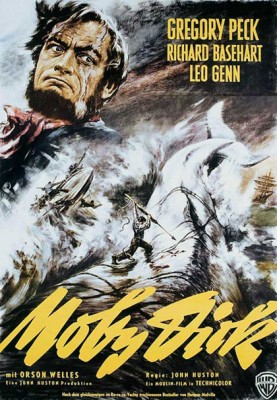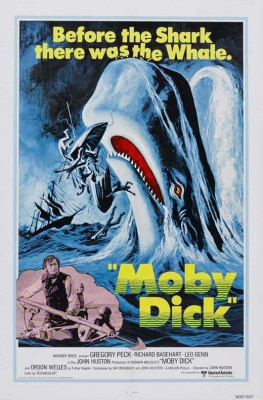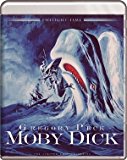| Reviews & Columns |
|
Reviews DVD TV on DVD Blu-ray 4K UHD International DVDs In Theaters Reviews by Studio Video Games Features Collector Series DVDs Easter Egg Database Interviews DVD Talk Radio Feature Articles Columns Anime Talk DVD Savant Horror DVDs The M.O.D. Squad Art House HD Talk Silent DVD
|
DVD Talk Forum |
|
|
| Resources |
|
DVD Price Search Customer Service #'s RCE Info Links |
|
Columns
|
|
|
Moby Dick (1956)
More than its daring color experimentation, Moby Dick is one of Huston's best films, though at the time it was neither a critical nor commercial success. Much of the blame then was laid at the feet of its star, Gregory Peck, who plays Captain Ahab. Peck himself disliked his performance, nor was he Huston's first or second choice but, as sometimes is the case, both actor and director were dead wrong: Peck is as magnificent as the film itself.
The movie is pretty much a complete success, impressively unlike any other seafaring adventure drama. It is at once both beguilingly realistic in its costume design, fidelity to both early-mid 19th century dialects and speech, and whaling, while at the same time is so highly stylized that it hypnotically plays like a fever dream. The other performances are equally splendid, and the special effects of the White Whale are impressive even by today's persnickety standards.
The 1978 rerelease poster on the right seems to be alluding to some sort of movie or another.
Huston's adaptation, co-written by Ray Bradbury, begins in 1840 in New Bedford, Massachusetts. Ishmael (Richard Basehart) arrives seeking adventure. He befriends tattooed harpooner Queequeg (Friedrich von Ledebur), a towering Polynesian prince (and, allegedly, cannibal). After Ishmael attends Father Marple's (Orson Welles) sermon on Jonah, ishmael and Queequeg sign aboard the Quaker-owned whaler Pequod, captained by the mysterious Ahab (Gregory Peck). Shortly before boarding, a scarecrow-like figure, Elijah (Royal Dano), warns the two sailors that Ahab shall beckon the crew from a watery grave and that all save one shall perish.
Melville's rich characters are gradually introduced and even enhanced, notably First Mate Starbuck (Leo Genn), a pious and methodical officer, the story's moral compass; Stubb (ubiquitous character actor Harry Andrews), a hearty, larger-than-life Second Mate; Pip (Tamba Allenby), the Alabama-born cabin boy, etc.
When Ahab finally appears on the quarterdeck, he declares his intentions to hunt the notorious Moby Dick, a massive white whale that years before took one of his legs (since replaced by a false one, carved from a whale's jawbone). After giving a stirring speech and promising a gold doubloon to the first man to sight Moby Dick (and later his share of the voyage to the crew upon the whale's death), the crew is all in save Starbuck, who increasingly views Ahab's mission as suicidal and his obsession as a sin against God almighty.
On big theater and home screens especially, Huston's Moby Dick is mesmerizing, just as the crew of the Pequod is mesmerized by Ahab's fevered charisma. He's clearly mad but equally captivating. Watching the film again, one notices that Ahab is but fleetingly glimpsed in a single shot early on, and then not seen again until about 40 minutes into the film, and after that is probably only actually onscreen for maybe 30 minutes at most. Bradbury's and Huston's careful building up of the mystery surrounding Ahab is such that, when he finally appears, he commands the audience's full attention. Peck delivers a fully committed performance rather than a hammy one. He's unquestionably out for vengeance but is also intelligent, experienced, and articulate, so that the crew's Pentecostal congregation-like response to Ahab's speeches are completely believable and nearly extend to the audience. Equal credit must go to Bradbury and Huston, who carefully preserved, edited and in some cases added to Melville's poetic dialogue.
Indeed, all of the performances range from excellent to superb. At 42, Basehart was really much too old to be playing a starry-eyed young whaler and audience surrogate; he was older even (by two years) than Peck, yet so good is his performance that he convinces us that he's much younger than he actually was. Equally fine is Leo Genn in his best film role, his British barrister roots apparently aiding his measured and subtle delivery. Orson Welles, in heavy makeup, is captivating as Father Marple, reportedly delivering in a single take his entire Jonah sermon. The fine cast extends even to the minor roles, with Bernard Miles's Manxman onscreen a lot but with little in the way of dialogue. An uncredited Patrick Troughton, early in his career, is barely noticeable until his one big scene, threatening Queequeg.
Austrian actor von Ledebur, born Friedrich Anton Maria Hubertus Bonifacius Graf von Ledebur-Wichein, was, to say the least, an improbable choice to play a Polynesian harpooner. Yet despite his thick accent he is beguiling and utterly convincing. Apparently a close and longtime friend of Huston's he appeared in three other films by the director and worked as a horse master in others. Though he worked as late as 1986's Ginger and Fred, the year of his death at 86, his only other memorable film role was as the aging German officer guarding POWs in Dresden in Slaughterhouse Five (1972).
The picture cost $4.4 million, very expensive by mid-1950s standards, but the money is there up on the screen. The special effects, primarily large scale miniatures of the whales shot in a studio tank and traveling mattes, combined with fleeting full-scale prop whales both at sea and on soundstage sets, blend seamlessly.
Some have noted the film's (and novel's) similarity to Shakespeare; colleague and friend DVD Savant likens it to Greek tragedy and ghost stories. To me, Moby Dick resembles the larger-than-life, dreamlike Soviet films from this period - anything but a big studio Hollywood film.
Video & Audio
John Huston periodically experimented with color during the 1950s and ‘60s. For Moby Dick he sought to replicate the look of 19th century engravings of whalers and whaling ships, and in so doing sucked out the color nearly to a monochromatic image. The effect, not uncommon in this digital age, was nearly unprecedented then, when Technicolor was commonly so richly saturated nitrate prints would practically make one's eyes bleed from overstimulation. Ultimately, I'd argue, the effect neither hurts nor particularly helps Moby Dick; it's an interesting look, but it doesn't enhance the viewing experience in any measurable way and at times teeters toward distracting.
More problematic is the film elements themselves. While thankfully presented for the first time in its proper 1.66:1 widescreen, the master appears sourced from a less pristine dupe negative that lacks the fine detail one is used to seeing on Blu-ray from other mid-fifties color titles. Curiously the final reel or two appear to be in slightly better shape, with more fine detail visible than the early reels. As the accompanying featurette makes plain via split-screen before and after examples, the image has been simultaneously desaturated and brightened, maximizing what is possible. Optional English subtitles have been included, the 1.0 DTS-HD Master Audio is excellent, and the disc is region-free.
Extra Features
Supplements, beyond the aforementioned featurette, include an audio commentary with Julie Kirgo (contributor also of the liner notes), Nick Redman, and literary scholar Paul Seydor; and an isolated score track.
Parting Thoughts
Certainly one of director John Huston's Best 10 films and a movie like no other, Moby Dick is a DVD Talk Collector Series title.
Stuart Galbraith IV is the Kyoto-based film historian largely absent from reviewing these days while he restores a 200-year-old Japanese farmhouse.
|
| Popular Reviews |
| Sponsored Links |
|
|
| Sponsored Links |
|
|
| Release List | Reviews | Shop | Newsletter | Forum | DVD Giveaways | Blu-Ray | Advertise |
|
Copyright 2024 DVDTalk.com All Rights Reserved. Legal Info, Privacy Policy, Terms of Use,
Manage Preferences,
Your Privacy Choices | |||||||















